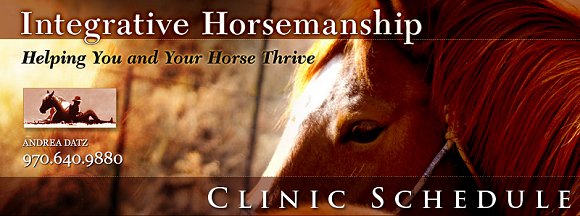Are you aware of how your postural habits affect your horse's ability to move and balance you on his back? How about your horse's postural habits? Does his way of carrying himself allow him to do his job efficiently? Pay attention to how you feel after a ride. Are you stiff and sore when you jump off your horse? Is your horse stiff and sore or have a sore back? If you're not sure about your horse, you can gauge how he's feeling about his riding by how willing he is to get caught the next day!
I'm sure most of you are thinking it's perfectly natural for horse and rider to be stiff and sore after a ride. What if there were a way to ride that you actually felt limber and energized when you got off? That is the fundamental goal of Bio Somatic Training, a series of workshops being offered all summer long on the western slope of Colorado.
To get a sense of what you will be learning I offer you this rider's checklist:
- When you mount your horse, pay attention to whether or not he'll stand quietly and wait for you to not only get on, but settle into the saddle, pick up your stirrups and your reins and wait until he is asked to step off. A horse that simply can't or won't stand still for mounting may not have good balance. Poor balance contributes to stumbling and spookiness, among other things. I rarely meet a horse that won't stand still for mounting for purely behavioral reasons.
- I find it useful to have my horse stand quietly while I mount and gather myself. It allows the opportunity to stop, settle into the weight of my bones, breath and notice where I might be carrying unnecessary tension in my body. Often I find I'm holding myself out of the saddle just a little rather than settling into it. So first step is to drop in, breath and notice where you might be carrying tension.
- Once I've determined where I'm holding excess tension (I say excess because obviously we need to stabilize in some areas to stay upright on the horse!) I continue to breath and focus on those areas of tension to see what I need to do to let them go. Having your body alignment correct is key to releasing tension so if you find you can't let it go you must start to investigate your position in the saddle to find what needs adjusting.
- I always begin with the foundation, my feet. Do I feel equal weight in both balls of my feet on the stirrups? The weight of my legs should be hanging into the stirrup without pushing or bracing.
- Are my thighs rolled inward allowing the weight of my leg to lengthen down and back toward my heel?
- Are my sit bones resting on the saddle?
- Are my pants zipped up? A useful visual image for engaging your lower abdominal muscles
- Can I feel the weight of my tail bone dropping toward the saddle and allowing length and softness in my low back?
- Is my trunk growing or reaching upward from my rooted base?
- Once I've found my base it's fun to see if I can be relaxed enough to feel my horse's breath move my legs.
I am finding this exercise extremely interesting to do on my rehab horses. If I go through my checklist and find that I simply cannot relax somewhere it is proving to be the horse that is bracing against me! Once I know that I can support the horse to relax his excess tension so that he can carry me in a balanced and relaxed way. This only takes a few moments to do before you walk off to start your ride but can make all the difference in the world to you and your horse.
I will keep posting new articles on a weekly basis so please go to my website: http://www.andreadatz.com/ and click the subscribe button if you would like to remain on this list. Feel free to e-mail me with any questions you may have or if you would like me to write about another topic related to Embodied Movement. I look forward to catching up with you this summer! Andrea Datz

